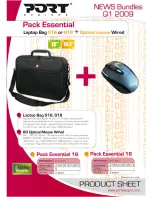
28
Notebook Essentials
Appendix C: Routine care
■
When traveling by air, carry the computer as hand luggage, and do not check it in with
the rest of your bags.
Ä
Avoid exposing a drive to magnetic fields. Security devices with magnetic fields
include airport walk-through devices and security wands. The airport security
devices that check carry-on luggage, such as conveyor belts, use X-rays instead of
magnetism and will not damage a drive.
■
In-flight computer use is at the discretion of the airline. If you plan to use the computer
during a flight, check with the airline in advance.
■
If the computer will be unused and disconnected from external power for more than
2 weeks, remove the battery pack and store it separately.
■
If you are shipping the computer or a drive, use suitable protective packaging and label
the package “FRAGILE.”
■
If the computer has a wireless device or a cell phone device installed, such as an
802.11b/g, a Global System for Mobile Communications (GSM), or a General Packet
Radio Service (GPRS) device, the use of these devices may be restricted in some
environments. Such restrictions may apply onboard aircraft, in hospitals, near
explosives, and in hazardous locations. If you are uncertain of the policy that applies to
the use of a particular device, ask for authorization to use it before you turn it on.
■
If you are traveling internationally, follow these suggestions:
❏
Check the computer-related customs regulations for each country or region on your
itinerary.
❏
Check the power cord and adapter requirements for each location in which you plan
to use the computer. Voltage, frequency, and plug configurations vary.
Å
To red
uc
e the risk of electric shock, fire, or damage to the equipment, do not
attempt to power the computer with a voltage converter kit sold for appliances.




































